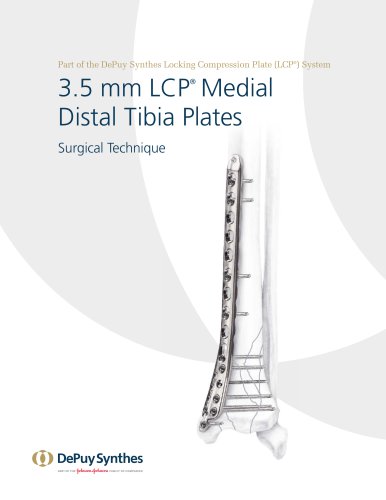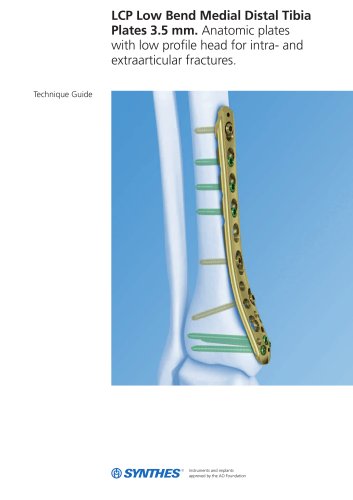 Website:
Depuy Synthes
Website:
Depuy Synthes
Group: Johnson & Johnson
Catalog excerpts
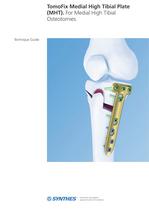
TomoFix Medial High Tibial Plate (MHT). For Medial High Tibial Technique Guide
Open the catalog to page 1
Image intensier control Warning This description alone does not provide sufficient background for direct use of the product. Instruction by a surgeon experienced in handling this product is highly recommended. Reprocessing, Care and Maintenance of Synthes Instruments For general guidelines, function control and dismantling of multi-part instruments, please refer to: www.synthes.com/reprocessing
Open the catalog to page 2
ntroduction TomoFix Medial High Tibial Plate (MHT) 2 Surgical Technique General Remarks 5 Positioning and Fixation of the Plate 23 Postoperative Treatment and Implant Removal 43 Product Information Plates 44 Also Available from Synthes: chronOS Wedges 53 TomoFix Medial High Tibial Plate (MHT) Technique Guide Synthes 1
Open the catalog to page 3
TomoFix Medial High Tibial Plate (MHT). For Medial High Tibial Osteotomies. Features and Benefits Higher stability Four locking screws in the plate head Long shaft portion Evenly transmits the occurring forces into the tibial shaft Compression of the lateral hinge A lag screw pulls the distal osteotomy segment towards the plate… 2 Synthes …and forces the plate into suspension, creating an elastic preload… TomoFix Medial High Tibial Plate (MHT) Technique Guide …which imposes pressure upon the lateral hinge.
Open the catalog to page 4
Easy plate insertion Compression of the lateral hinge TomoFix technique allows pretension- ng of the plate using cortex screw and TomoFix Knee Osteotomy System TomoFix Tibial Head Plate medial, proximal wedge high tibial - Increased plate strength preload technique stable bridging small stature versions TomoFix Tibial Head Plate lateral, proximal wedge osteotomies stable fixation - Available in right and left TomoFix Femoral Plate medial, distal stable fixation - Available in right and left TomoFix Femoral Plate lateral, distal wedge osteotomies stable fixation - Available in right and left...
Open the catalog to page 5
Indications and Contraindications Indications: − Open-wedge and closed-wedge osteotomies of the medial proximal tibia − Unicompartmental medial or lateral gonarthrosis with malalignment of the proximal tibia − Idiopathic or posttraumatic varus or valgus deformity of the proximal tibia Contraindication: − Inflammatory arthritis 4 Synthes TomoFix Medial High Tibial Plate (MHT) Technique Guide
Open the catalog to page 6
General Remarks Open-wedge corrective tibia osteotomies are increasingly being used for joint-preserving surgery of the knee joint. The TomoFix knee osteotomy system is based on the Locking Compression Plate system (LCP) and enables angular-stable connections between the screw and plate. This angular stability allows the stable fixation of an open-wedge osteotomy and hence its rapid osseous healing. Note: Plan the type and position of the osteotomy. The TomoFix medial high tibial plate is suitable for both open and closed-wedge osteotomies. This technique guide will explain the procedure of...
Open the catalog to page 7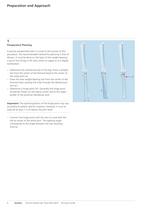
Preparation and Approach 1 Preoperative Planning A precise preoperative plan is crucial to the success of this procedure. The recommended method for planning is that of Miniaci. It must be done on the basis of the weight-bearing x-ray of the full leg in AP view, either on paper or at a digital workstation. − Determine the mechanical axis of the leg: Draw a straight line from the center of the femoral head to the center of the ankle joint (a). − Draw the new weight-bearing line from the center of the femoral head, passing the knee through the desired position (a’). − Determine a hinge point...
Open the catalog to page 8
- Determine the entry point of the transverse osteotomy. It ies just above the pes anserinus. Make sure there is still enough space for the plate head, so that the screw in hole D can be inserted without protruding into the wedge. De- pending on the determined opening angle and the length of the osteotomy cut (mediolateral diameter of the os- teotomy) the corresponding opening height can be de- rived from Hernigou's trigonometric chart. Trigonometric chart Correction angle Note: These instructions alone do not replace in-depth train- ng in planning for osteotomies. It only serves as a...
Open the catalog to page 9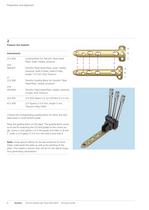
312.924 Guiding Block for TomoFix Tibial Head Plate, small, medial, proximal 440.831 TomoFix Tibial Head Plate, small, medial, proximal, shaft 4 holes, head 4 holes, length 112 mm. Pure Titanium 312.926 TomoFix Guiding Block for TomoFix Tibial Head Plate, medial, proximal 440.834 TomoFix Tibial Head Plate, medial, proximal, 4 holes. Pure Titanium 323.042 LCP Drill Sleeve 5.0, for Drill Bits 0 4.3 mm Choose the corresponding guiding block for either the stan- dard sized or small TomoFix plate. Place the guiding block on the plate. The guiding block serves as an aid for attaching the LCP...
Open the catalog to page 10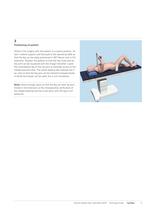
3 Positioning of patient Perform the surgery with the patient in a supine position. Attach a lateral support and foot pad to the operating table so that the leg can be easily positioned in 90° flexion and in full extension. Position the patient so that the hip, knee and ankle joint can be visualized with the image intensifier. Lower the contralateral leg at the hip joint to facilitate access to the medial proximal tibia. The sterile draping also exposes the iliac crest so that the leg axis can be checked intraoperatively. A sterile tourniquet can be used, but is not mandatory. Note: Allow...
Open the catalog to page 11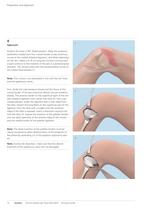
Preparation and Approach 4 1 Approach Position the knee in 90° flexed position. Mark the anatomic landmarks (medial joint line, cranial border of pes anserinus, course of the medial collateral ligament, and tibial tuberosity) on the skin. Make a 6 – 8 cm long skin incision running from a point anterior to the insertion of the pes in a posterocranial direction. The incision ends over the posteromedial corner of the medial tibial plateau.(1) Note: This incision runs essentially in line with the skin lines and the saphenous nerve. First, divide the subcutaneous tissues and the fascia at the...
Open the catalog to page 12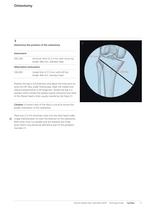
Osteotomy 1 1 Determine the position of the osteotomy Instrument 292.260 Kirschner Wire л 2.5 mm with trocar tip, length 280 mm, Stainless Steel >15 mm Alternative instrument 338.002 Guide Wire л 2.5 mm with drill tip, length 300 mm, Stainless Steel >30 mm Position the leg in full extension and adjust the knee joint exactly into AP view under fluoroscopy. Align the medial and lateral compartments in AP projection. Rotate the leg in a position which locates the patella exactly anteriorly (one third of the fibular head is then usually covered by the tibia).(1) Caution: A correct view of the...
Open the catalog to page 13All Depuy Synthes catalogs and technical brochures
-
ZERO-P NATURAL™PLATE
5 Pages
-
2.0 mm LCP® Distal Ulna Plate
20 Pages
-
SYNFLATE SYSTEM
3 Pages
-
2.4 mm VA LCP™
4 Pages
-
Building on Success
16 Pages
-
HEALIX ADVANCE
4 Pages
-
RADIUS OF CURVATURE
3 Pages
-
Introducing The Variable Angle
12 Pages
-
HEALIX Anchor™ 3.4 mm
2 Pages
-
Small Battery Drive II
4 Pages
-
HEALIX ADVANCE
4 Pages
-
3.5 mm LCP™ Medial
15 Pages
-
Titanium Sternal Fixation System
34 Pages
-
MatrixRIB®FixationSystem
86 Pages
-
Mandible Trauma Solutions
2 Pages
-
Power line II
4 Pages
-
Concorde
28 Pages
-
LCP Intercarpal
31 Pages
-
LCS® COMPLETE™
2 Pages
-
Synthes TPLO.
8 Pages
-
SynFix-LR System
56 Pages
-
ATB Anterior Tension Band Plate
32 Pages
-
CONDUIT™
15 Pages
-
Brochure_FINAL
2 Pages
-
DePuy Synthes
81 Pages
-
Anspach
3 Pages
-
Orthopedic Foot Instruments
32 Pages
-
PINNACLE® Hip Solutions
12 Pages
-
Corail
24 Pages
-
S-ROM® NOILES™
68 Pages
-
TRI-LOCK® Product Rationale
12 Pages
-
Reclaim Surgical Technique
44 Pages
-
Speed
2 Pages
-
attune
80 Pages
-
HAMMERLOCK® 2
2 Pages
-
DePuy Glenoid Solutions
2 Pages
-
Trauma Solutions. Elbow
4 Pages
-
Polar
4 Pages
-
Alveolar Distractor.
4 Pages
-
Piezoelectric System
4 Pages
-
Air Power Line II
6 Pages
-
LCP Clavicle Hook Plate
4 Pages
-
TruMatch Pin Guides
16 Pages
-
P F N A
8 Pages
-
SKILL, DEDICATION,
16 Pages
-
Orthopaedics. Overview
20 Pages
-
DURALOC
16 Pages
-
Marathon Cemented Cup
20 Pages
-
REEF Surgical Technique
16 Pages
-
MatrixNEURO
8 Pages
-
Anspach XMax
4 Pages
-
Anspach eMax 2 Plus
4 Pages
-
Small Electric Drive
4 Pages
-
Air Pen Drive
4 Pages
-
Colibri II
4 Pages
-
Spine
25 Pages
-
Expert Hindfoot Arthrodesis Nail
48 Pages
-
LCP Distal Fibula Plates
32 Pages
-
Expert Tibial Nail PROtect
16 Pages
-
Expert Tibia Nail
84 Pages
-
Sacral Bars
16 Pages
-
Pelvic C-Clamp
20 Pages
-
Low Profile Pelvic System
16 Pages
-
Proximal Femoral (Hook) Plate
24 Pages
-
LCP
24 Pages
-
PFNA
112 Pages
-
HCS 1.5, 2.4, 3.0
36 Pages
-
LCP Wrist Fusion
32 Pages
-
LCP Compact Hand
28 Pages
-
VA-LCP Elbow
48 Pages
-
Distal Radius
44 Pages
-
Olecranon
30 Pages
-
LCP Hook Plate
28 Pages
-
DHP & Olecranon
4 Pages
-
LCP S-A
4 Pages
-
Epoca
4 Pages
-
Philos
32 Pages
-
MultiLoc
68 Pages














